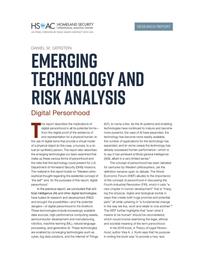Emerging Technology and Risk Analysis
Digital Personhood
ResearchPublished Apr 8, 2025
This report describes the implications of digital personhood in all its potential forms — the digital proof of the existence of and representation for a physical human, use of digital twins that provide a virtual model of a physical object (in this case, a human), and virtual (or synthetic) persons. The report also describes the emerging technologies that make up these various forms of personhood and the risks that this technology could present.
Digital Personhood
ResearchPublished Apr 8, 2025

This report is one in a series of analyses on the effects of emerging technologies on U.S. Department of Homeland Security (DHS) missions and capabilities. As part of this work, the research team was charged with developing a technology and risk assessment methodology for evaluating emerging technologies and understanding their implications within a homeland security context. The methodology and analyses provide a basis for DHS to better understand the emerging technologies and the risks presented.
This report describes the implications of digital personhood in all its potential forms — from the digital proof of the existence of and representation for a physical human, to the use of digital twins that provide a virtual model of a physical object (in this case, a human), to a virtual (or synthetic) person. The report also describes the emerging technologies that the research team examined that make up these various forms of personhood and the risks that this technology could present for DHS missions.
This research was sponsored by the U.S. Department of Homeland Security (DHS) Science and Technology Directorate and conducted by the Management, Technology, and Capabilities Program of the Homeland Security Research Division (HSRD).
This publication is part of the RAND research report series. Research reports present research findings and objective analysis that address the challenges facing the public and private sectors. All RAND research reports undergo rigorous peer review to ensure high standards for research quality and objectivity.
RAND is a nonprofit institution that helps improve policy and decisionmaking through research and analysis. RAND's publications do not necessarily reflect the opinions of its research clients and sponsors.